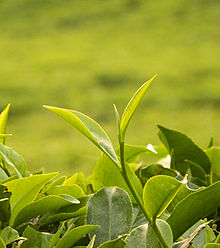Camellia sinensis
| Camellia sinensis | |
|---|---|
 |
|
 |
|
| Camellia sinensis foliage | |
| Scientific classification | |
| Kingdom: | Plantae |
| (unranked): | Angiosperms |
| (unranked): | Eudicots |
| (unranked): | Asterids |
| Order: | Ericales |
| Family: | Theaceae |
| Genus: | Camellia |
| Species: | C. sinensis |
| Binomial name | |
|
Camellia sinensis (L.) Kuntze |
|
| Synonyms | |
|
|
Camellia sinensis is a species of evergreen shrub or small tree whose leaves and leaf buds are used to produce tea. It is of the genus Camellia (Chinese: 茶花; pinyin: Cháhuā, literally: "tea flower") of flowering plants in the family Theaceae. Common names include "tea plant", "tea shrub", and "tea tree" (not to be confused with Melaleuca alternifolia, the source of tea tree oil, or Leptospermum scoparium, the New Zealand teatree).
Two major varieties are grown: Camellia sinensis var. sinensis for Chinese teas, and Camellia sinensis var. assamica for Indian Assam teas.White tea, yellow tea, green tea, oolong, pu-erh tea and black tea are all harvested from one or the other, but are processed differently to attain varying levels of oxidation. Kukicha (twig tea) is also harvested from Camellia sinensis, but uses twigs and stems rather than leaves.
The name Camellia is taken from the Latinized name of Rev. Georg Kamel,SJ (1661–1706), a Moravian-born Jesuit lay brother, pharmacist, and missionary to the Philippines.
...
Wikipedia
